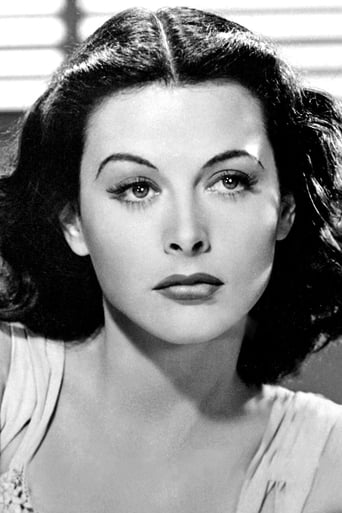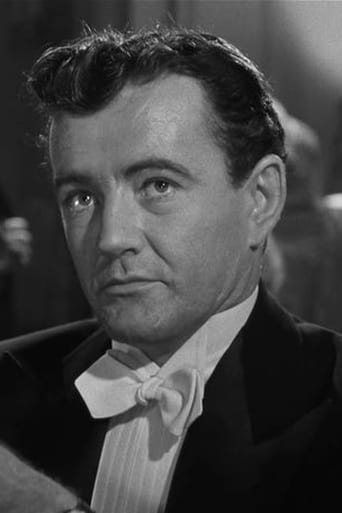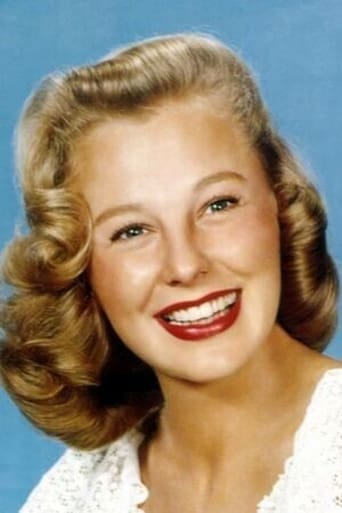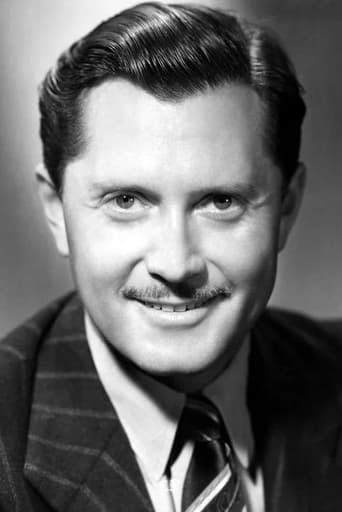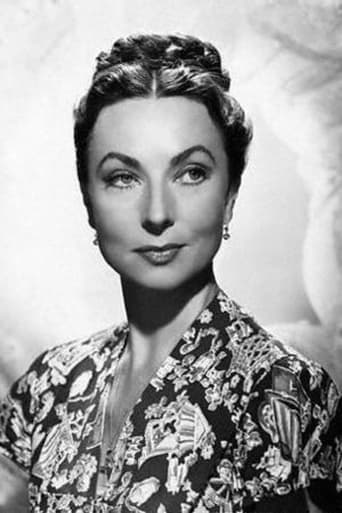Hellen
I like the storyline of this show,it attract me so much
Brendon Jones
It’s fine. It's literally the definition of a fine movie. You’ve seen it before, you know every beat and outcome before the characters even do. Only question is how much escapism you’re looking for.
Calum Hutton
It's a good bad... and worth a popcorn matinée. While it's easy to lament what could have been...
Stephanie
There is, somehow, an interesting story here, as well as some good acting. There are also some good scenes
rhoda-9
If a movie gives you Hedy Lamarr to look at, it seems churlish to complain. But even the presence of one of the most beautiful women who ever lived, plus the adorable June Allyson and the endearing Robert Walker do not begin to compensate for the hideously vulgar and phoney goings-on.This routine princess-falls-in-love-with-ordinary-American comedy is joined with a love story between Walker and Allyson, the woman he really loves without realising it. |Nothing wrong with that, but she is paralysed from the waist down. Why? Because--the doctor gives us his medical opinion--in childhood she was not loved enough!Can you imagine the feelings of parents of crippled children on hearing such a thing? Back in the Forties, most people would have thought such a question absurdly oversensitive, but now it's a matter of common decency. Not only that, there is a long dream sequence in which Allyson imagines herself, in a feathered evening gown, dancing with Walker. Worse yet, at the end she actually begins to walk! and starts dancing with him! In the absence of a FAIRY princess to wave a magic wand, this is repulsively vulgar and cruel.Not only that, but Allyson is portrayed in a manner right out of cheap Victorian sentimentality. She does not sit in an ugly wheelchair but reclines on a couch, rising from it only when Walker, visiting her in the evenings, carries her to the roof for some fresh air. I wonder if any kid in the audience ever piped up, "How does she go to the bathroom?" She has a lovely flat, full of antiques and beautifully kept, which is understandable, as she works at painting dolls, and earns as much as--$3 a day! Poor June! She spends the whole film in cotton pyjamas or a floor-length, high-collared, puffed-sleeve nightie, while Hedy gets to float around in one fabulous evening gown after another.Some more hypocrisy: The princess wants to see some low life, so Walker, very reluctantly and apologetically, takes her to a place where the floor show is a couple in 19th-century costume, singing "Wait Till the Sun Shines, Nellie." Positively decadent! One man punches another, leading to the kind of phoney free-for-all that happens only in the movies. I have always wondered why, if two men start fighting in a saloon, other men should suddenly start fighting each other all over the place, and women should whack them over the head with bottles. Any suggestions?
Catfishbunter
***Spoiler Warning*** This film is a light-hearted comedy which takes on the air of a fairy tale. In fact, it jumps right into the fairy tale motif with a "once upon a time" narration that tenuously connects a princess from an unnamed kingdom of ambiguous origins to a "grand city" that is unmistakably New York. The plot centers on a love triangle, or love quadrangle to be more precise, between the lovable bellboy, Jimmy Dobson, his physically handicapped friend Leslie, a (presumably) European princess, and a brooding European baron. The plot unfolds into a well-traveled trope: the princess is mistaken for a commoner, spends the day with a working class Joe, falls in love with him, and ultimately has to choose between a life as respected royalty or one where she follows her heart and marries beneath her station. Jimmy and Princess Veronica's fairy-tale ending is challenged, not only by the significant difference in social standing, but by the Veronica's dour ex-amour and by Jimmy's guilt for ignoring his sick friend and potential partner Leslie. In addition to the awkward love triangle, the film weaves through many mostly-unnecessary subplots and features a heaping helping of Albert, Jimmy's dimwitted porter friend. The film is largely forgettable in all contexts. Neither its romantic pairings (alternating between Jimmy and Veronica, Veronica and her baron, Jimmy and Leslie, and Albert and Leslie) nor its comedic bits (ranging from cringe-worthy one-liners to fights scenes meant to be humorous but evoking the dullest of physical comedy) work. The subplots are distracting, the dream sequence bizarre, and the ending unsatisfying. This is one fairy tale which should have been left on the shelf.The plot itself is bloated with so many unnecessary and distracting subplots (perhaps as filler for the lackluster main plot) that it is hard for the audience to care deeply about what happens. Examples of these distractions include Albert's penchant for petty crimes and Jimmy's desire to keep him out of the employ of a particularly brutish street thug, Leslie's illness which has left her crippled and Jimmy's desire to help her get better (apparently according to the doctor she is just sad and Jimmy's love can help her legs work again), Jimmy's financial woes and his desire to buy an expensive radio, Veronica's mysterious past with her ex-husband and ex-lover, the success of Leslie's Santa Claus painting business (really, that is really a sub-plot), and the exploits of a newspaper journalist writing a story on Jimmy and Veronica. Most of these distracting scenes are simply excuses for quips and one-liners or zany physical comedy, such as getting into an intendedly humorous fight with street thugs which was indistinguishable from a rugby scrum; at worst, they are unexplained and jarring departures from the story. The main story focuses on the relationship between Princess Veronica and Jimmy, and explores the clichéd scenario of a princess being mistaken for a common woman. This storyline has a proved track record, and has worked to great effect in Roman Holiday and even the animated film Aladdin, and excellent variations of this "princess and the commoner" theme, where a huge gap in social or cultural standing exist, include The Princess Comes Across, Ninotchka, Here is my Heart, and It Happened One Night. To varying degrees, these films worked, and ranged effectively from screwball comedy to heartfelt romance. The same cannot be said for Her Highness and the Bellboy. The fault for the film failing to match the artistic success of even its low-budget contemporaries lies with the script, but also with Hedy Lamarr's turn as the princess. Lamarr's princess lacks the spunk, charm, and exuberance of Audrey Hepburn's later portrayal of the archetype in Roman Holiday, yet she doesn't have the humorously distant detachment and ignorance of common culture seen in Greta Garbo's Ninotchka. Instead, she falls somewhere in between the two: not quite sober and reserved enough to be a funny foil for Robert Walker's Jimmy, and not quite excited or chipper enough to appear changed or affected by her romance with a bellboy. She is, in a word, boring. The fact that the princess maintains a servile relationship with Jimmy throughout the film hamstrings any attempt to make their love story believable. Similarly, Jimmy's unabashed altruism leaves his character a bit one-dimensional and renders his romance with either Veronica or Leslie problematic; he is always trying to save the girls, Leslie from her paralysis and Veronica from her responsibilities as a ruler.The film also feels cheap and technically deficient, with poor direction, even when compared to low-budget contemporaries. The lighting for the film is distracting, the film apparently used full frontal flood lighting which created an array of glints and glares throughout the picture, led to awkward shadows, and destroyed any illusion or reality. The sets for the castle are remarkably fake looking and the static city skyline in various scenes looks cheap and lazy. Leslie's dream sequence is a mixed bag: the fading technique and shots creating the illusion of her dream and ultimate ascension to the castle in the sky were well done, nothing revolutionary but a believable sequence of movie magic. The dream sequence itself, complete with a handicapped June Allyson dancing away with giant frogs, Santa Claus, chorus girls, and Rags Ragland's goofy king seems jarringly and bizarrely out of place with the rest of the film. The real strength of the movie is Robert Walker's performance as Jimmy. Walker is charismatic, likable, suave, and approachable. He shines through the film's weaknesses and shows chops as a leading man. Rags Ragland's performance as the oafish Albert likely garnered laughs when the film first aired, but his irreverent japes and madcap physical comedy routines have aged very poorly. At one point, Albert tells Leslie that he didn't mean to make her laugh. I don't think he will have to worry about that with modern audiences.
wndlz
Some viewers may view this film as just another old-fashioned movie. To me, this was very clean, fresh, and genuinely funny and entertaining film. There are no complicated gimmicks or special effects, but it exemplifies the best traits of human beings; optimism, good humor, romantic love, and the kind of respect that a decent human being would show, in all of their relationships. If anything, it would be nice if we could seriously ponder these values as being worthy, instead of dismissing them, as being old fashion or downright sappy. Hedy was the personification of regal elegance, but with a warm heart; Robert Walker, was very likable and funny; June Allyson, Rags Ragland, were as warmly effective as the two leads. A very positive and sensitive film. Too bad these qualities make this a 'chick flick' in today's world. I know there was a time, when a family could enjoy a movie like this, without feeling weird, because their adrenaline drives were not being satisfied by glorified violence, and a general disrespect for anything decent or human.
spirit11
WARNING: This review may reveal portions of the film plot.If you are a fan of old films simply for the sake of their age, then this might be a film you would enjoy. Most others would not be impressed with this film.Unfortunately, the storyline is obvious, although I'll admit at the end of the film you aren't sure if the two people in love will figure it out in time. The movie seems to run a bit long as well, dragging out the inevitable ending.If all that sounds like this is a bad film, it isn't. It is a typical love story of the 40s film genre, however there really aren't any "bad guys" in this film, which might account for some of where the film seems to run long. You want to cheer for the hero, but there is no villain for the hero to fight against.All in all, the film is sweet, definitely what would be referred to as a "chick flick." If you catch it, that's fine, but you don't need to worry if you miss it.

